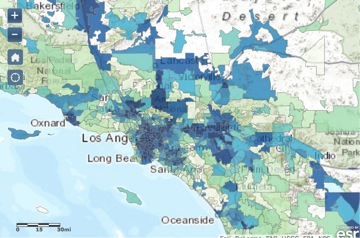California’s Most Polluted Neighborhoods Home To Ethnic Minorities

According to a report from the Office of Environmental Health Hazard Assessment, ethnic minorities, particularly Latinos and African Americans, make up a large proportion of residents in the most polluted neighborhoods despite making up a relatively small percentage of the statewide population.
An online tool called the CalEnviroScreen depicts California’s pollution levels by ZIP code using a color scale. According to the OEHHA’s report, it represents immediate pollution levels and “potential vulnerability” for the pollution of a community. Initially launched in 2012, the tool has recently been updated to include racial and ethnic makeup of a population.
Clumps of dark blue represent the state’s most polluted areas. Los Angeles and the San Joaquin Valley encompass the worst scoring ZIP codes.
The report finds that African Americans, who make up less than 13 percent of the statewide population, comprise almost a third of the worst polluted ZIP codes.
Latinos, another ethnic minority group, make up a large majority of the ten percent most polluted ZIP codes. Only 37.6 percent of California residents are Latino.
What accounts for this disproportion?
Ed Avol, an expert on air pollution and its impact on public health, believes there is a socioeconomic element to consider.
“Simply put, people tend to live where they can afford to, and people generally prefer to live among their peers,” said Avol.
Others believe the connection between ethnic minorities and polluted neighborhoods is related to career opportunist rather than social circumstances.
Roberto Cabrales, a community organizer for Communities for a Better Environment in Huntington Park, attributed the link to job availability.
“It’s important to consider the historic make-up of the community,” Cabrales said. “There was a demographic change in Southeast Los Angeles in the ‘70s and ‘80s when immigrants started fleeing gang activity and started buying homes here—affordability is a key factor and these weren’t the best paying jobs, which is why Latinos tended to go after them.”
Avol pointed out that lower-rent areas are in less desirable locations, often near busy freeways or industrial facilities. People who live in these neighborhoods often get overlooked when it comes to political determinations, he said.
“Without a political ally to represent their community’s point of view, people tend to get ignored in key developmental decisions such as where a new freeway or rail yard may be built, and these facilities are rarely built in highly affluent places like Beverley Hills or Palos Verdes,” Avol said.
However, certain community groups are working hard to get the attention of their legislatures to help eliminate pollution in their neighborhoods. CBE has built its organization around the mission to “build people’s power in California’s communities of color and low income communities to achieve environmental health and justice.”
Cabrales says his primary responsibility is to engage the local community to hold elected officials and polluters responsible for cleaning up the neighborhoods.
“We’re surrounded by manufacturing hubs, stationary sources [of pollution] that produce and handle chemicals, body shops, power plants, and mobile pollution,” said Cabrales. “We’re boxed in by all the major freeways in Southern California, which elevates our risk for cancer so we make sure every decision being made involves the community.”
Reach Staff Reporter Alex Janin here.



